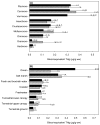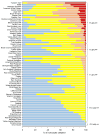Avian mercury exposure and toxicological risk across western North America: A synthesis
- PMID: 27093907
- PMCID: PMC5365029
- DOI: 10.1016/j.scitotenv.2016.03.071
Avian mercury exposure and toxicological risk across western North America: A synthesis
Abstract
Methylmercury contamination of the environment is an important issue globally, and birds are useful bioindicators for mercury monitoring programs. The available data on mercury contamination of birds in western North America were synthesized. Original data from multiple databases were obtained and a literature review was conducted to obtain additional mercury concentrations. In total, 29219 original bird mercury concentrations from 225 species were compiled, and an additional 1712 mean mercury concentrations, representing 19998 individuals and 176 species, from 200 publications were obtained. To make mercury data comparable across bird tissues, published equations of tissue mercury correlations were used to convert all mercury concentrations into blood-equivalent mercury concentrations. Blood-equivalent mercury concentrations differed among species, foraging guilds, habitat types, locations, and ecoregions. Piscivores and carnivores exhibited the greatest mercury concentrations, whereas herbivores and granivores exhibited the lowest mercury concentrations. Bird mercury concentrations were greatest in ocean and salt marsh habitats and lowest in terrestrial habitats. Bird mercury concentrations were above toxicity benchmarks in many areas throughout western North America, and multiple hotspots were identified. Additionally, published toxicity benchmarks established in multiple tissues were summarized and translated into a common blood-equivalent mercury concentration. Overall, 66% of birds sampled in western North American exceeded a blood-equivalent mercury concentration of 0.2 μg/g wet weight (ww; above background levels), which is the lowest-observed effect level, 28% exceeded 1.0 μg/g ww (moderate risk), 8% exceeded 3.0 μg/g ww (high risk), and 4% exceeded 4.0 μg/g ww (severe risk). Mercury monitoring programs should sample bird tissues, such as adult blood and eggs, that are most-easily translated into tissues with well-developed toxicity benchmarks and that are directly relevant to bird reproduction. Results indicate that mercury contamination of birds is prevalent in many areas throughout western North America, and large-scale ecological attributes are important factors influencing bird mercury concentrations.
Keywords: Bioaccumulation; Birds; Eggs; Mercury; Toxicity Benchmarks.
Published by Elsevier B.V.
Figures












References
-
- Ackerman JT, Eagles-Smith CA. Integrating toxicity risk in bird eggs and chicks: using chick down feathers to estimate mercury concentrations in eggs. Environ Sci Technol. 2009;43:2166–2172. - PubMed
-
- Ackerman JT, Eagles-Smith CA, Herzog MP, Hartman CA. Maternal transfer of contaminants in birds: mercury and selenium concentrations in parents and their eggs. Environ Pollut. 2016a;210:145–154. - PubMed
-
- Ackerman JT, Eagles-Smith CA, Herzog MP, Yee JL, Hartman CA. Egg laying sequence influences egg mercury concentrations and egg size in three bird species: implications for contaminant monitoring programs. Environ Toxicol Chem. 2016b In Press. - PubMed
Publication types
MeSH terms
Substances
Grants and funding
LinkOut - more resources
Full Text Sources
Other Literature Sources

